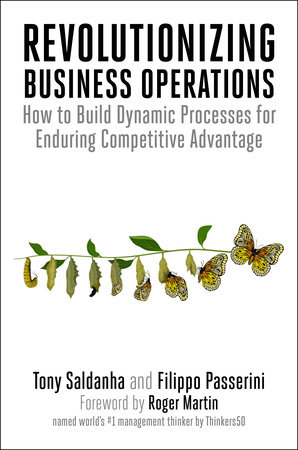Quick Summary
One Sentence Summary
“Revolutionizing Business Operations” by Tony Saldanha and Filippo Passerini provides a comprehensive guide on how to transform business operations using innovative digital strategies.
Big Idea
The core concept of the book revolves around harnessing the power of digital transformation to revolutionize business operations, emphasizing the need for organizations to adapt and evolve in the fast-paced digital era.
Five Key Ideas
- Digital Transformation as a Necessity: Understanding why and how digital transformation is not just an option but a necessity for businesses to stay competitive.
- Practical Frameworks and Models: Introducing practical frameworks and models that can be applied to any business for effective digital transformation.
- Case Studies and Real-world Examples: Providing a range of case studies from various industries to illustrate the successful application of these strategies.
- Overcoming Challenges: Discussing common challenges faced during digital transformations and strategies to overcome them.
- Future-Proofing Businesses: Offering insights on how businesses can continuously adapt to emerging technologies and market changes to stay relevant.
Actionable Advice
The book offers actionable advice on implementing digital transformation strategies, such as setting clear objectives, involving all levels of the organization, and staying adaptable to change.
About the Author
Tony Saldanha and Filippo Passerini are seasoned professionals in the field of business operations and digital transformation, with extensive experience in leading large-scale change in multinational corporations.
Read Next
- “Digital Transformation: Survive and Thrive in an Era of Mass Extinction” by Thomas M. Siebel
- “Leading Digital: Turning Technology into Business Transformation” by George Westerman, Didier Bonnet, and Andrew McAfee
- “The Digital Transformation Playbook: Rethink Your Business for the Digital Age” by David L. Rogers
In Depth
Digital Transformation as a Necessity
In today’s fast-paced business world, digital transformation isn’t just a trend; it’s a must-do for survival. Saldanha and Passerini drill this point home in “Revolutionizing Business Operations.” They argue that the digital era has fundamentally changed how businesses operate, and those who don’t adapt will be left behind.
This key idea is built on the understanding that technology isn’t a luxury or an add-on; it’s a core part of modern business strategy. The authors emphasize that digital transformation is about more than just using new tech tools; it’s about rethinking entire business models and processes to capitalize on digital opportunities.
A striking example from the book highlights General Electric’s (GE) transformation journey. Once known primarily for industrial machinery, GE recognized the need to evolve in the digital age. They invested heavily in digital infrastructure, focusing on data analytics and the Internet of Things (IoT). This shift allowed them to offer enhanced services like predictive maintenance for their industrial products, significantly increasing their value to customers. This move not only diversified GE’s revenue streams but also positioned them as a leader in the digital industrial space.
The authors quote from the book encapsulates this transformation:
“GE’s journey reflects a profound understanding of digital transformation as a necessity. It’s about seeing the digital wave as an opportunity to redefine the business, not just a threat to existing practices.”
This example illustrates how embracing digital transformation can open up new business avenues and create opportunities for growth that were previously unimaginable. It’s not just about keeping up with competitors but about redefining what a company can be in the digital age.
Saldanha and Passerini further explain that digital transformation requires a mindset shift. Businesses need to be willing to experiment, fail, learn, and iterate quickly. This approach is different from traditional business strategies that favor slow, deliberate planning. In the digital world, agility and adaptability are key.
The importance of customer-centricity in the digital transformation process is also highlighted. The authors stress that understanding and meeting the evolving needs of customers in the digital age is crucial. This involves leveraging data analytics, AI, and other digital tools to gain insights into customer behavior and preferences, allowing businesses to offer personalized experiences and solutions.
In conclusion, this key idea from “Revolutionizing Business Operations” stresses that digital transformation is not optional; it’s essential. It’s a comprehensive overhaul of how businesses think, operate, and deliver value in the digital age. By taking a leaf from GE’s book and embracing this necessity, businesses can not only survive but thrive in today’s ever-evolving digital landscape.
Practical Frameworks and Models
When it comes to transforming a business digitally, having a solid plan is crucial. Saldanha and Passerini provide readers with practical frameworks and models that can be applied to any business, regardless of size or industry. These tools are designed to guide leaders through the digital transformation process, ensuring they cover all bases from strategy to execution.
One significant model discussed in the book is the ‘Five-Stage Digital Transformation Framework’. This framework breaks down the transformation journey into five distinct stages: Foundation, Siloed, Partially Synchronized, Fully Synchronized, and Living DNA. Each stage represents a progressive level of digital integration and sophistication within the business.
A detailed example from the book highlights Procter & Gamble’s (P&G) use of this framework. P&G began their digital transformation journey by establishing a strong digital foundation, focusing on building a robust IT infrastructure. As they progressed, they moved through the stages, integrating digital technologies across different departments. By the time they reached the ‘Fully Synchronized’ stage, P&G had achieved a harmonious blend of technology and business processes, leading to improved efficiency and innovation. Their journey didn’t stop there; they continuously evolved, making digital transformation a part of their corporate DNA.
The authors describe P&G’s journey using this quote:
“P&G’s success with the Five-Stage Digital Transformation Framework showcases the power of a structured approach. It’s about evolving in stages, ensuring each step builds on the last, towards a fully integrated digital future.”
This example demonstrates how using a structured framework can simplify the complex process of digital transformation. It provides a clear roadmap, helping businesses to prioritize their efforts and measure their progress.
The book also emphasizes the importance of customizing these frameworks and models to fit the unique needs and context of each business. The authors suggest starting with an assessment of the current digital maturity of the organization and then using the frameworks to identify areas for improvement and growth.
Another key aspect highlighted is the role of leadership in successfully applying these frameworks. Leaders need to understand and champion the digital transformation process, ensuring that the organization’s culture and mindset align with the digital goals. They must also be prepared to invest time and resources into training and upskilling employees to adapt to new digital tools and processes.
In short, this key idea from the book stresses the importance of having a clear, structured approach to digital transformation. By utilizing practical frameworks and models, like the ‘Five-Stage Digital Transformation Framework’, businesses can navigate the complexities of digital change effectively. This approach not only provides a clear path forward but also ensures that each step in the transformation journey builds towards a more digitally integrated and innovative future.
Case Studies and Real-world Examples
Understanding digital transformation isn’t just about theories and models; it’s also about seeing them in action. Saldanha and Passerini bring this to life with a variety of case studies and real-world examples. These stories showcase how different companies, across various industries, have successfully embraced digital transformation, offering valuable insights and practical takeaways.
One such example is Netflix’s evolution from a DVD rental service to a streaming giant. The case study delves into how Netflix used digital technologies to disrupt the entertainment industry. Initially, they capitalized on the internet’s potential to offer a more convenient DVD rental service. However, their real game-changer was the pivot to streaming. By leveraging data analytics, they were able to personalize recommendations, significantly enhancing user experience. They didn’t stop there; Netflix ventured into content production, using insights derived from their massive data to create hit shows tailored to viewer preferences.
The authors reflect on Netflix’s strategy with this quote:
“Netflix’s transformation demonstrates the power of leveraging digital technology not just to improve existing services, but to completely redefine a business model. It’s a lesson in staying ahead of the curve by continuously innovating.”
This example underscores a crucial aspect of digital transformation: the willingness to rethink and reinvent. Netflix didn’t just use digital tools to enhance their existing business model; they transformed it entirely, staying ahead of industry shifts and consumer behaviors.
Another critical takeaway from these case studies is the importance of customer focus. Digital transformation is not just about implementing new technologies; it’s about using these technologies to better understand and serve customers. Whether it’s through personalized services, enhanced customer experiences, or new products, the ultimate goal is to add value to the customer.
These real-world examples also highlight the need for agility and flexibility. Companies like Netflix succeeded because they were quick to adapt to changes in technology and consumer behavior. They were willing to experiment, take risks, and, importantly, learn from both successes and failures.
The book’s case studies serve not only as inspiration but also as a blueprint. They provide readers with practical insights into how companies can navigate the digital landscape, from initial steps to full-scale transformation. These stories demonstrate that while the path to digital transformation may vary, the principles of innovation, customer-centricity, and adaptability are universal.
In essence, this key idea reinforces the value of learning from others’ experiences. By studying a range of case studies, businesses can gain a deeper understanding of the strategies, challenges, and successes involved in digital transformation. These real-world examples offer a rich source of knowledge and inspiration, helping guide businesses on their own digital journeys.
Overcoming Challenges
Every journey has its bumps, and the road to digital transformation is no exception. Saldanha and Passerini don’t shy away from discussing the challenges businesses face during this process. They offer insights into common hurdles and provide strategies to overcome them, emphasizing that foreseeing and managing these challenges is key to successful transformation.
A compelling example provided in the book is about a major bank’s struggle with legacy systems. The bank, facing stiff competition from fintech startups, realized the need to modernize its digital infrastructure. However, the transition was fraught with difficulties. Integrating new technologies with old systems was a significant challenge, leading to compatibility issues and disruptions in service.
The authors highlight the bank’s approach with this quote:
“Facing legacy system challenges, the bank didn’t just attempt a full-scale overhaul overnight. Instead, it strategically modernized in phases, ensuring stability while gradually introducing innovations.”
This example illustrates that while embracing new technologies is essential, it needs to be balanced with the realities of existing infrastructures. The bank’s phased approach allowed them to innovate without compromising the stability of their core services.
Another challenge discussed is the resistance to change within organizations. Employees can be wary of new technologies and processes, fearing job loss or a steep learning curve. To address this, the authors stress the importance of transparent communication and employee involvement in the transformation process.
Creating a culture that embraces change is vital. The authors suggest involving employees at all levels in the transformation process, from planning to implementation. This not only helps in easing fears and resistance but also harnesses valuable insights from those who know the company best.
Risk management is another key challenge in digital transformation. The book discusses how businesses need to anticipate and prepare for potential risks associated with digital initiatives, such as data breaches or technology failures. Implementing robust security measures and having contingency plans in place are critical steps in mitigating these risks.
The book also touches upon the challenge of maintaining momentum. Digital transformation is not a one-time project but an ongoing journey. The authors advise setting clear, achievable goals and celebrating small wins to keep the momentum going. This approach helps in maintaining focus and motivation throughout the transformation journey.
In summary, this key idea addresses the reality that digital transformation is not a smooth, straightforward process. It comes with its set of challenges, from technical issues like legacy system integration to human factors like resistance to change. By acknowledging these challenges and adopting strategic approaches to overcome them, businesses can navigate the complexities of digital transformation more effectively. This part of the book serves as a guide for anticipating, understanding, and managing the hurdles that inevitably arise on the path to becoming a digitally advanced organization.
Future-Proofing Businesses
Staying relevant in the rapidly evolving digital landscape is like hitting a moving target. Saldanha and Passerini dedicate a significant part of their book to discussing how businesses can future-proof themselves, ensuring they remain competitive and adaptable in the face of constant technological change.
A standout example from the book is the story of Amazon. Known for its relentless innovation, Amazon has continuously evolved, from an online bookstore to a global e-commerce giant, and now a leader in cloud computing and AI. The authors delve into how Amazon’s culture of ‘customer obsession’ and its willingness to experiment and innovate have been central to its ability to stay ahead.
The authors sum up Amazon’s approach with this quote:
“Amazon’s success lies in its foresight and agility. They’ve mastered the art of anticipating customer needs and swiftly adapting to meet them, making them a prime example of future-proofing in action.”
This example underscores the importance of staying attuned to customer needs and market trends. Amazon’s ability to anticipate and quickly respond to changes has allowed them to consistently lead the market and enter new domains successfully.
One key aspect of future-proofing discussed in the book is the importance of fostering a culture of innovation within the organization. This involves encouraging creativity, experimentation, and a willingness to take calculated risks. It’s about creating an environment where new ideas are welcomed and failure is seen as a learning opportunity.
The authors also highlight the need for continuous learning and adaptation. As technologies and market dynamics change, businesses must be willing to adapt their strategies and business models. This might mean investing in new technologies, retraining staff, or even pivoting to new markets or product lines.
Another critical factor is the use of data to drive decision-making. In the digital age, data is a goldmine of insights into customer behavior, market trends, and operational efficiencies. Businesses that can effectively gather, analyze, and act on data insights are better positioned to anticipate and respond to future challenges and opportunities.
Building strategic partnerships is also emphasized as a way to future-proof businesses. In a complex digital ecosystem, no company can operate in isolation. Forming alliances with technology providers, industry peers, and even competitors can provide businesses with the resources, knowledge, and networks they need to stay ahead.
In essence, this key idea stresses that future-proofing is not just about keeping up with current trends; it’s about constantly looking ahead and preparing for what’s next. It’s about creating a business that is resilient, adaptable, and always ready to embrace change. By adopting a forward-thinking approach, as exemplified by companies like Amazon, businesses can not only survive but thrive in the ever-changing digital landscape.
Actionable Advice
- Set Clear Digital Goals: Define specific, measurable objectives for your digital transformation journey.
- Involve Everyone: Engage all levels of the organization, from top executives to frontline employees, in the transformation process.
- Focus on Customer Needs: Continuously gather and analyze customer data to understand and anticipate their evolving needs.
- Embrace a Culture of Innovation: Foster an environment where experimentation and risk-taking are encouraged.
- Invest in Training: Provide training and resources to help employees adapt to new digital tools and processes.
- Prioritize Data Security: Implement robust security measures to protect data and maintain customer trust.
- Stay Agile and Adaptable: Be prepared to pivot strategies in response to new technologies and market changes.
- Celebrate Small Wins: Acknowledge and celebrate progress and milestones to maintain momentum.
- Leverage Partnerships: Build strategic partnerships to gain access to new technologies, skills, and markets.
- Keep Learning: Stay informed about emerging digital trends and innovations to continually future-proof your business.
About the Author
Tony Saldanha is a globally recognized expert in digital transformation and business process management. With over 30 years of experience, primarily at Procter & Gamble (P&G), he has a proven track record in leading large-scale digital changes in multinational corporations. His tenure at P&G included roles like Vice President of Global Business Services and IT, where he drove innovation and efficiency. Saldanha’s expertise lies in creating resilient business models and leveraging technology for competitive advantage. He believes strongly in the power of digital transformation to revolutionize business operations and maintain relevance in the rapidly changing digital world. His approach emphasizes practical, scalable strategies, and a focus on execution excellence. Saldanha is not only a thought leader but also an author and consultant, passionate about helping organizations navigate the complexities of digital transformation. His work is characterized by a blend of strategic insight and hands-on experience, making him a sought-after voice in the field.
Read These Next
You might like these similar books
- “Digital Transformation: Survive and Thrive in an Era of Mass Extinction” by Thomas M. Siebel
- “Leading Digital: Turning Technology into Business Transformation” by George Westerman, Didier Bonnet, and Andrew McAfee
- “The Digital Transformation Playbook: Rethink Your Business for the Digital Age” by David L. Rogers
- “The Age of Agile: How Smart Companies Are Transforming the Way Work Gets Done” by Stephen Denning
- “Exponential Organizations: Why New Organizations Are Ten Times Better, Faster, and Cheaper Than Yours (and What to Do About It)” by Salim Ismail, Michael S. Malone, and Yuri van Geest
FAQ
Q: What is the main focus of ‘Revolutionizing Business Operations’?
A: The book focuses on digital transformation in business operations, emphasizing the necessity of adopting digital strategies to stay competitive in the modern era.
Q: Who should read this book?
A: It’s ideal for business leaders, managers, and professionals involved in digital transformation or interested in modernizing their company’s operations.
Q: Does the book provide practical guidance?
A: Yes, it offers practical frameworks and models for implementing digital transformation strategies effectively in businesses.
Q: Are there real-world examples in the book?
A: Yes, the book includes various case studies from different industries to illustrate successful digital transformation strategies.
Q: What challenges in digital transformation does the book address?
A: The book discusses challenges like legacy system integration, resistance to change, and risk management, offering strategies to overcome them.
Q: Does the book discuss future trends in business operations?
A: Yes, it covers how businesses can future-proof themselves by staying adaptable and innovative in the face of continuous technological change.
Q: Is the content suitable for those new to digital transformation?
A: Absolutely, the book is written in simple language with clear concepts, making it accessible to beginners as well as seasoned professionals.







